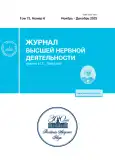RECOGNITION OF ORAL SPEECH ACCORDING TO MEG DATA BY COVARIANCE FILTERS
- Authors: Verkhlyutov V.M.1, Burlakov E.O.2, Gurtovoy K.G.3, Vvedensky V.L.3
-
Affiliations:
- Higher Nervous Activity of a Person Lab., Institute of Higher Nervous Activity and Neurophysiology of RAS
- Derzhavin Tambov State University
- RNC Kurchatov Institute
- Issue: Vol 73, No 6 (2023)
- Pages: 800-808
- Section: ФИЗИОЛОГИЯ ВЫСШЕЙ НЕРВНОЙ (КОГНИТИВНОЙ) ДЕЯТЕЛЬНОСТИ ЧЕЛОВЕКА
- URL: https://journals.rcsi.science/0044-4677/article/view/233007
- DOI: https://doi.org/10.31857/S0044467723060126
- EDN: https://elibrary.ru/SWHXYB
- ID: 233007
Cite item
Full Text
Abstract
Speech recognition based on EEG and MEG data is the first step in the development of BCI and AI systems for their further use in inner speech decoding. Great advances in this direction have been made using ECoG and stereo-EEG. At the same time, there are few works on this topic on the analysis of data obtained by non-invasive methods of recording brain activity. Our approach is based on the evaluation of connections in the space of sensors with the identification of a pattern of MEG connectivity specific for a given segment of speech. We tested our method on 7 subjects. In all cases, our processing pipeline was quite reliable and worked either without recognition errors or with a small number of errors. After “training”, the algorithm is able to recognise a fragment of oral speech with a single presentation. For recognition, we used segments of the MEG recording 50–1200 ms from the beginning of the sound of the word. For high-quality recognition, a segment of at least 600 ms was required. Intervals longer than 1200 ms worsened the recognition quality. Bandpass filtering of the MEG showed that the quality of recognition is equally effective in the entire frequency range. Some decrease in the level of recognition is observed only in the range of 9–14 Hz.
Keywords
About the authors
V. M. Verkhlyutov
Higher Nervous Activity of a Person Lab., Institute of Higher Nervous Activity and Neurophysiology of RAS
Author for correspondence.
Email: verkhliutov@ihna.ru
Russia, Moscow
E. O. Burlakov
Derzhavin Tambov State University
Email: verkhliutov@ihna.ru
Russia, Tambov
K. G. Gurtovoy
RNC Kurchatov Institute
Email: verkhliutov@ihna.ru
Russia, Moscow
V. L. Vvedensky
RNC Kurchatov Institute
Email: verkhliutov@ihna.ru
Russia, Moscow
References
- Anumanchipalli G.K., Chartier J., Chang E.F. Speech synthesis from neural decoding of spoken sentences. Nature. 2019. 568 (7753): 493–498. https://doi.org/10.1038/s41586-019-1119-1
- Anurova I., Vetchinnikova S., Dobrego A., Williams N., Mikusova N., Suni A., Palva S. Event-related responses reflect chunk boundaries in natural speech. NeuroImage, 2022. 255 (April), 119203. https://doi.org/10.1016/j.neuroimage.2022.119203
- Arnulfo G., Wang S.H., Myrov V., Toselli B., Hirvonen J., Fato M.M., Palva J.M. Long-range phase synchronization of high-frequency oscillations in human cortex. Nature Communications, 2020. 11 (1): 5363. https://doi.org/10.1038/s41467-020-18975-8
- Che B., Ciria L.F., Hu C., Ivanov P.C. Ensemble of coupling forms and networks among brain rhythms as function of states and cognition. Communications Biology, 2022. 5 (1): 82. https://doi.org/10.1038/s42003-022-03017-4
- Dash D., Ferrari P., Wang J. Decoding Imagined and Spoken Phrases From Non-invasive Neural (MEG) Signals. Frontiers in Neuroscience. 2020. 14: 290. https://doi.org/10.3389/fnins.2020.00290
- Défossez A., Caucheteux C., Rapin J., Kabeli O., King J.-R. Decoding speech from non-invasive brain recordings. ArXiv. 2022. 2208. 12266: 1–15. http://arxiv.org/abs/2208.12266
- Huth A.G., De Heer W.A., Griffiths T.L., Theunissen F.E., Gallant J.L. Natural speech reveals the semantic maps that tile human cerebral cortex. Nature. 2016. 532 (7600): 453–458. https://doi.org/10.1038/nature17637
- Liaukovich K., Ukraintseva Y., Martynova O. Implicit auditory perception of local and global irregularities in passive listening condition. Neuropsychologia, 2022. 165 (July 2020): 108129. https://doi.org/10.1016/j.neuropsychologia.2021.1-08129
- Lizarazu M., Carreiras M., Molinaro N. Theta-gamma phase-amplitude coupling in auditory cortex is modulated by language proficiency. Human Brain Mapping, 2023. 44 (7): 2862–2872. https://doi.org/10.1002/hbm.26250
- Neymotin S.A., Tal I., Barczak A., O’Connell M.N., McGinnis T., Markowitz N., Lakatos P. Detecting Spontaneous Neural Oscillation Events in Primate Auditory Cortex. Eneuro. 2022. 9 (4), ENEURO.0281-21.2022. https://doi.org/10.1523/ENEURO.0281-21.2022
- Norman-Haignere S.V., Long L.K., Devinsky O., Doyle W., Irobunda I., Merricks E.M., Mesgarani N. Multiscale temporal integration organizes hierarchical computation in human auditory cortex. Nature Human Behaviour. 2022. 6 (3): 455–469. https://doi.org/10.1038/s41562-021-01261-y
- Proix T., Delgado Saa J., Christen A., Martin S., Pasley B.N., Knight R.T., Giraud A.-L. Imagined speech can be decoded from low- and cross-frequency intracranial EEG features. Nature Communications, 2022. 13 (1), 48. https://doi.org/10.1038/s41467-021-27725-3
- Rolls E.T., Deco G., Huang C.-C., Feng J. The human language effective connectome. NeuroImage, 2022. 258: 119352.
- Sato N. Cortical traveling waves reflect state-dependent hierarchical sequencing of local regions in the human connectome network. Scientific Reports, 2022. 12 (1): 334. https://doi.org/10.1038/s41598-021-04169-9
- Tang J., LeBel A., Jain S., Huth A.G. Semantic reconstruction of continuous language from non-invasive brain recordings. Nature Neuroscience. 2023. https://doi.org/10.1038/s41593-023-01304-9
- Verkhlyutov V. MEG data during the presentation of Gabor patterns and word sets. Zenodo, 2022. https://zenodo.org/record/7458233
- Vvedensky V., Filatov I., Gurtovoy K., Sokolov M. Alpha Rhythm Dynamics During Spoken Word Recognition. Studies in Computational Intelligence, 2023. 1064: 65–70.https://doi.org/10.1007/978-3-031-19032-2_7
Supplementary files















